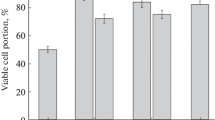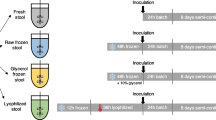Abstract
A comparative analysis of the survival rate of the human gut microbiota after low-temperature preservation under the protection of penetrating (dimethylsulfoxide and glycerol), nonpenetrating (gelatin) and gas (helium) protectors was performed. Increased resistance of intestinal bacteria to the effect of low temperatures was revealed. A significant portion of the bacteria (50.0 ± 3.0%) remained viable after freezing in liquid nitrogen without the cryoprotector(s). The greatest survival was achieved under the protection of 5% dimethylsulfoxide (86.0 ± 4.0%), 5% glycerol (82.0 ± 5.2%), and 10% gelatin (75.0 ± 5.0%). The combination of cell-penetrating (dimethylsulfoxide and glycerol) and nonpenetrating (gelatin) protectors did not lead to a synergistic effect. The use of atmospheric helium for cryoprotection of heterogeneous human gut microbiota did not increase its survival, even in combination with such powerful protectors as dimethylsulfoxide and glycerol, which indicates the need to optimize cryoprotection media, in particular, for strict anaerobes.




Similar content being viewed by others
REFERENCES
S. Possemiers, C. Grootaert, J. Vermeiren, et al., Cur. Pharmaceut. Design 15, 2051 (2009).
Y. A. Poluektova, O. S. Lyashenko, O. S. Shifrin, et al., Russ. J. Gastroenterol. Hepatol. Coloproctol. 24, 85 (2014).
M. J. Blaser and S.Falkow, Nature Rev. Microbiol. 7, 887 (2009).
A. Barzegari, S. Eslami, Gh. Elham, and O. Yadollah, Front. Microbiol. 31 (5), 393 (2014). https://doi.org/10.3389/fmicb.2014.00393
A. Barzegari, N. Saeedi, and A. Saei, Future Microbiol. 9 (5), 639 (2014).
D. P. Bojanova and S. R. Bardenstein, PLoS Biol. 14, e1002503 (2016).
D. V. Smirnova, L. V. Zalomova, A. V. Zagainova, et al., Int. J. Med. Microbiol. 309, 259 (2019).
C. L. Lauber, N. Zhou, J. I. Gordon, et al., FEMS Microbiol. Lett. 307 (1), 80 (2010).
M. I. Bahl, A. Bergstrom, and T. R. Licht, FEMS Microbiol. Lett. 329, 193 (2012).
I. M. Carroll, T. Ringel-Kulka, J. P. Siddle, et al., PLoS One 7 (10), e46953 (2012).
F. Fouhy, J. Deane, M. C. Rea., et al., PLoS One 10 (3), e0119355 (2015).
N. Gaci, P. P. Chaudhary, W. Tottey, et al., Microb. Ecol. Health Disease 28, 1308070 (2017). https://doi.org/10.1080/16512235.2017.1308070
L. Bircher, C. Schwab, A. Geirnaert, and C. Ch. Lacroix, Microb. Biotechnol. 11 (1), 163 (2018).
O. Plakash, Y. Nimonkar, and Y. Shouche, FEMS Microbiol. Lett. 339, 1 (2013).
B. A. Shenderov, E. N. Gakhova, M. A. Manvelova, et al., RF Patent No. RU 2123044 (1998).
F.-M. Kerckhof, E. N. P. Courtens, A. A. Geirnaert, et al., PLoS One 9 (6), e99517 (2014).
A. Criste, M. Giuburuncă, O. Negrea, et al., Animal Sci. Biotechnol. 47 (2), 73 (2014).
B. J. Fuller, CryoLetters 25, 375 (2004).
R. C. Chian, in Fertility Cryopreservation, Ed. by R.-C. Chian and R. Quinn (Cambridge Univ. Press, Cambridge, 2010), pp. 1–9.
M. Hasan, A. E. R. Fayter, and M. I. Gibson, Biomacromolecules 19 (8), 3371 (2018). https://doi.org/10.1021/acs.biomac.8b00660
Z. Hubalek, Cryobiology 46, 205 (2003).
D. Smith, M. J. Ryan, and E. Stackebrandt, in Encyclopedia of Life Support Systems. Biotechnology, Ed. by H. W. Doelle and E. J. DaSilva (EOLSS, Oxford, 2012).
S. V. Ugraitskaya, N. V. Shishova, E. L. Gagarinskiy, et al., Biophysics (Moscow) 63 (3), 387 (2018).
A. I. Netrusov, M. A. Egorova, L. M. Zakharchuk, et al., A Practical Course in Microbiology (Akademiya, Moscow, 2005), pp. 103–104.
D. B. Roszak and R. R. Colwell, Microbiol. Rev. 51 (3), 365 (1987).
V. A. Gant, G. Warres, I. Philips, and G. F. Savidge, J. Med. Microbiol. 39 (2), 147 (1993).
T. Chen, A. Fowler, and M. Toner, Cryobiology 40, 277 (2000).
F. W. Kleinhans, Cryobiology 37, 271 (1989).
T. Nei., T. Araki, and T. Matsusaka, in Freezing and Drying of Microorganisms, Ed. by T. Nei (Tokyo: Univ. of Tokyo Press, 1969).
H. T. Meryman, R. J. Williams, and M. S. J. Douglas, Cryobiology 14, 287 (1977).
P. Mazur, in Principles of Cryobiology in Life in the Frozen State, Ed. by B. J. Fuller, N. J. Lane, and E. E. Benson (CRC Press, Boca Raton, FL, 2004), pp. 3–65.
M. J. Prentice and J. Farrant, J. Clin. Microbiol. 6, 4 (1977).
H. T. Meryman, Annu. Rev. Bioph. Bioeng. 3, 341 (1974).
Funding
This research was carried out with the financial support of the RFBR, project no. 19-34-90187, as well as a contract no. 0373100122118000037.
Author information
Authors and Affiliations
Corresponding author
Ethics declarations
Conflict of interests. The authors declare that they have no conflicts of interest.Statement on the welfare of humans or animals. This article does not contain any studies involving animals performed by any of the authors.
Additional information
Translated by E. Puchkov
Abbreviations: DMSO—dimethyl sulfoxide.
Rights and permissions
About this article
Cite this article
Zalomova, L.V., Reshetnikov, D.A., Ugraitskaya, S.V. et al. The Efficiency of the Preservation of Human Gut Microbiota in Liquid Nitrogen Depending on the Composition of the Cryoprotective Medium. BIOPHYSICS 65, 788–794 (2020). https://doi.org/10.1134/S000635092005022X
Received:
Revised:
Accepted:
Published:
Issue Date:
DOI: https://doi.org/10.1134/S000635092005022X




